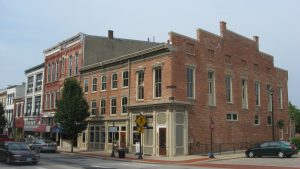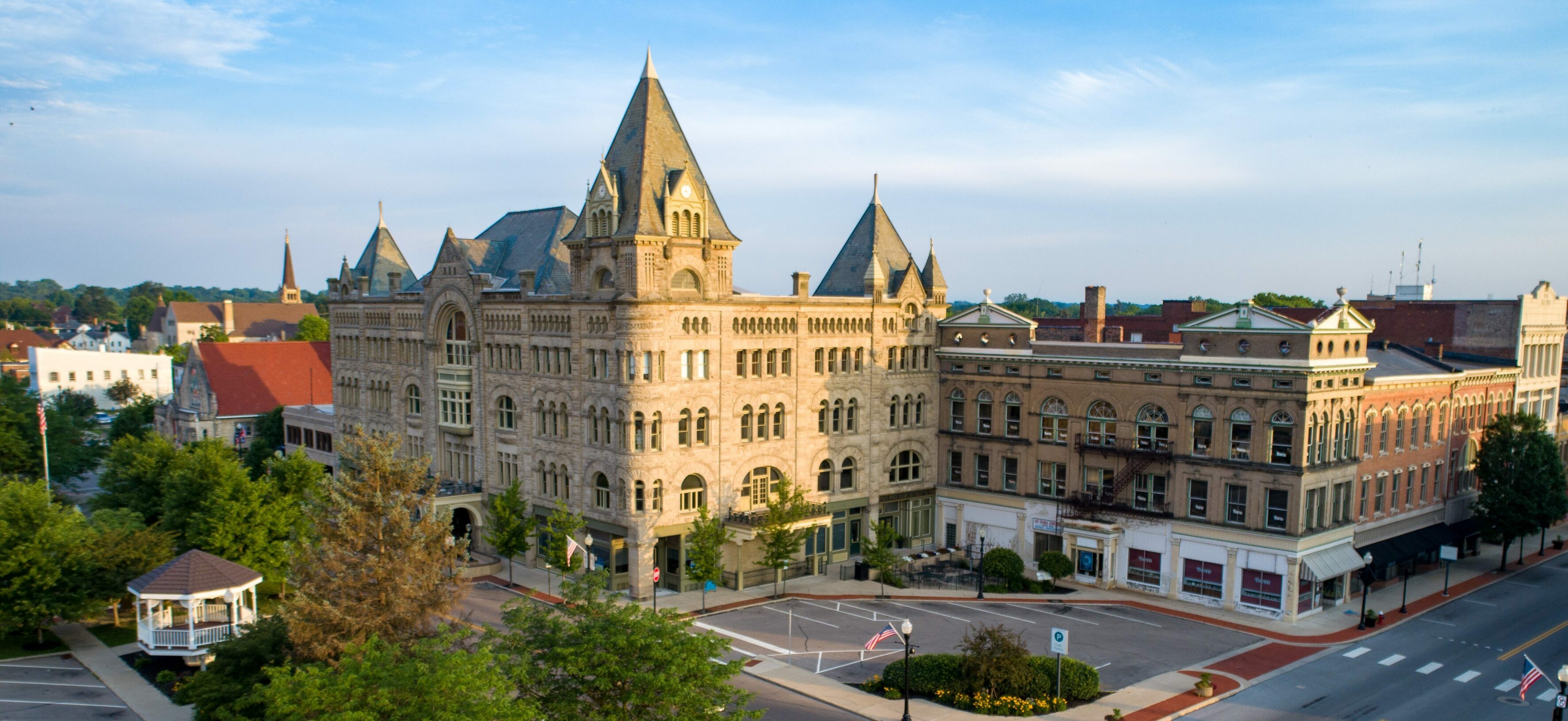About Piqua
Here’s a little bit about the city of Piqua if you are looking for a Tax Attorney Piqua Ohio.
Piqua (/ˈpɪkwə/ PIK-wə) is a city in Miami County, southwest Ohio, United States, 27 miles north of Dayton. The population was 20,522 at the 2010 census. It is part of the Dayton Metropolitan Statistical Area.
It was founded as the village of Washington in 1807 by a soldier under Gen. Anthony Wayne.
The word ‘Piqua’ is believed to be derived from a Shawnee language phrase: Othath-He-Waugh-Pe-Qua, translated as “He has risen from the ashes,” related to a legend of the people. It became associated with the Pekowi, one of the five divisions of the Shawnee people, who were eventually known as the Piqua.
In 1749, Fort Pickawillany was constructed by the British to protect their trading post at a Miami village of the same name. It was located at the confluence of Loramie Creek and the Great Miami River. (The present city of Piqua developed about a mile to the southwest).
In 1752 Charles de Langlade, an Odawa war chief of partial French Canadian descent, attacked the fort. He led more than 240 Odawa and Ojibwe warriors allied with French forces against the British and the Miami village in the Battle of Pickawillany. The Miami chief and a British trader were killed in the conflict.
After the battle, the British and Miami abandoned this site. The Miami rebuilt Pickawillany, and Piqua later developed near their village. The British soon took over the area after defeating the French in the French and Indian War.
Until 1780, Piqua had been the capital town of the Shawnee located on the Mad River about 23 miles southeast of the modern town (near Springfield). That year, an expedition by Gen. George Rogers Clark culminated in the Battle of Piqua, after which the town and surrounding fields were burned. The Shawnee relocated north and west to the Great Miami River. Piqua was settled as two separate Shawnee villages late in 1780, known as Upper Piqua and Lower Piqua.
In 1790, General Harmar found the site on the Great Miami River abandoned and in ruins, as did General Wayne in 1794.
As Gen. Anthony Wayne’s Legion was returning to Greenville via Loramie’s trading post and Piqua at the termination of their Indian Country campaign in fall 1794, Wayne wrote a letter to Henry Knox dated Oct. 17, 1794, in which he recommended that forts be built at those two locations as waystations along the Miami River. A detachment of Wayne’s forces from Greenville built or repaired a small fort and supply depot named Fort Piqua in Upper Piqua on the same site as the (later) farm of Col. John Johnston in winter 1794–95. Capt. J.N. Visher was made commander of the garrison. The fort was garrisoned through 1794 and 1795, and abandoned after the signing of the Treaty of Greenville in 1795.
By 1795, most of Ohio’s Shawnee had moved to Missouri and those that remained migrated north to the Auglaize – the southwestern Indian towns were no more. Piqua itself was well below the Greenville Treaty line and would remain abandoned until white settlers arrived.
Piqua was one of the cities that suffered severe flooding during the Great Dayton Flood of 1913.
Piqua is nestled in a sweeping “S” bend of the Miami River and experienced regular flooding before the “Great Flood of 1913.” A cupboard door on a home on East Water Street, just up from the river shows the various heights of water in that home. *The 1913 flood was marked in the middle of an upstairs window.
Piqua was home to the first municipally operated nuclear power plant, the Piqua Nuclear Generating Station. It operated from 1962 to 1966, leading to Piqua being nicknamed “The Atomic City.” This major demonstration project was a failure. The United States Atomic Energy Commission (now US Department of Energy) bought out the contract with the City of Piqua, in order to terminate the operations early. During this period a name brand automotive battery was manufactured and marketed locally as the “Piqua Atomic Power Plant.”
Piqua has two Main Streets, one being north and southbound along Miami County Road 25-A (the former U.S. Route 25, also known as the Dixie Highway); the other running east through Shawnee. U.S. 36 also runs through much of the city, cutting the town almost directly in half. Main and Ash streets (U.S. 36) converge in Piqua’s downtown. Also running through downtown is the east–west Conrail corridor; originally built as the Pennsylvania Railroad two-track throughway, this track was abandoned in 1985 during restructuring of the railroad industry. A section of it was renovated as a bike trail in the summer of 2001, and it is now known as Linear Park. The remaining rail line serving Piqua is the north and southbound Baltimore and Ohio line, now operated by CSX Transportation (CSXT).
As of the census of 2010, there were 20,522 people, 8,318 households, and 5,425 families residing in the city. The population density was 1,766.1 inhabitants per square mile (681.9/km2). There were 9,311 housing units at an average density of 801.3 per square mile (309.4/km2). The racial makeup of the city was 92.4% White, 3.3% African American, 0.2% Native American, 0.7% Asian, 0.4% from other races, and 2.9% from two or more races. Hispanic or Latino of any race were 1.4% of the population.
There were 8,318 households, of which 32.6% had children under the age of 18 living with them, 44.9% were married couples living together, 14.2% had a female householder with no husband present, 6.1% had a male householder with no wife present, and 34.8% were non-families. 28.7% of all households were made up of individuals, and 12.2% had someone living alone who was 65 years of age or older. The average household size was 2.44 and the average family size was 2.96.
The median age in the city was 38.1 years. 24.8% of residents were under the age of 18; 8.7% were between the ages of 18 and 24; 25.6% were from 25 to 44; 26.2% were from 45 to 64; and 14.7% were 65 years of age or older. The gender makeup of the city was 48.0% male and 52.0% female.
The city of Piqua is the home of Hartzell Propeller, a producer of small aircraft propellers. Evenflo (formerly Questor Juvenile Furniture) is the leading manufacturer of infant and toddler car seats, and has become one of Piqua’s leading employers and industries.
In the late 1890s, Southwest Ohio was the heart of the US flaxseed growing area. There were some 13 linseed oil mills in Piqua, where the flaxseed was “crushed” to extract the vegetable oil, named linseed oil. The flax fiber was used to make both cloth and paper. The oil had a variety of industrial uses. Linoleum is a manufactured flooring product for which linseed oil is the binder. One of the vegetable oil mills in Piqua burned down in the 1890s, a common fate for wooden buildings soaked with vegetable oil. Its owner, American Linseed Oil Company, dispatched Alfred Willard French, their Chief Engineer, from Brooklyn, New York, to organize and supervise the rebuilding of the oil mill.
If you are looking for a tax attorney Piqua Ohio, you are at the right spot. Give us a call today at 330-331-7611.









